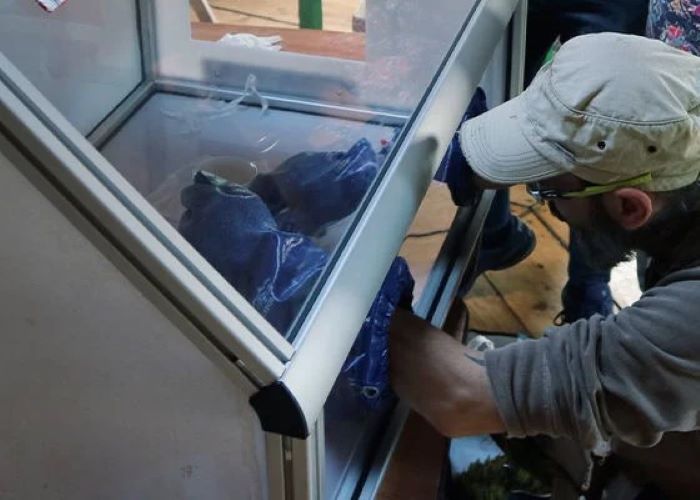Once subject only to the forces of nature, the cultivation of psilocybin mushrooms has not only moved into the home environment, but has also made a rapid transition from an extravagant hobby to a widespread trend on a shoestring budget. It is worth noting that many ethnobotanists are attracted not so much to the fruits of their labor as to the process of creating those fruits, which bears only a passing resemblance to a sacrament of initiation into the secrets of the universe. There's a certain magic to it, don't you think?
By putting together a number of rather familiar components in a certain order and proportions, one can end up with an organic substance that has an absolutely scientifically inexplicable effect on the human body. However, in delving too deeply into the metaphysical aspect of shrooming, growers and beginners in particular tend to overlook the purely technical side of the process. At first glance, it may seem quite difficult to master, which makes many beginners want to rely on their luck and neglect these or those recommendations. Once you understand the algorithm of cultivation, you will find that only a few basic principles need to be followed to ensure the success of your efforts. One of these pillars is sterility, which is the subject of our article.
The Necessity of a Sterile Environment

In mushroom cultivation, sterility refers to the absence of microorganisms that can compete with the mycelium for nutrients and suppress its development. Unlike plants, mushrooms do not convert inorganic compounds into organic ones through the process of photosynthesis. Instead, they grow inside their future food by means of filamentous (thread-like) formations – hyphae (from the ancient Greek, ὑφή – web), which, through the secretion of specific enzymes, break down organic substances into digestible elements and then absorb them along with water. This type of feeding not only provides the mushrooms with an abundance of nutrients, but also makes them highly susceptible to contamination by competing microorganisms, which also produce metabolites that are toxic to the mycelium.
Sterility serves as a protective barrier, shielding the spawn from the need to resist invasion from unwanted guests while providing exclusive access to the nutrient medium. This approach has a positive effect on the rate and extent of colonization, which is reflected in quantitative and qualitative yield indicators. It's simple. If there is no need to fight with invaders, it means that it is possible to hurl all the effort into the colonization of the substrate, and the stronger and more massive the spawn, the more massive the fruiting bodies will be.
An essential aspect of sterility is the continuity of these activities. Decontamination procedures should be performed on an ongoing basis each time mycelium, substrate, or growing media is processed. Untreated tools, equipment, containers, and fruiting chamber can be the source of contamination that can jeopardize not only the current cycle, but all subsequent cycles as well. Maintaining sterility at every stage minimizes the risk of spreading pathogens and ensures the continued success of your mushroom cultivation efforts.
Wild and Homegrown Mushrooms
In the context of the above, the logical question is: "If sterility is so important in the cultivation of magic mushrooms, how do they survive in the wild?". The answer lies in the same competition. In nature, mushrooms have evolved together with other microorganisms, forming a symbiosis or developing an effective strategy to fight them, trying to adapt to the available conditions and grab their piece of the ecological pie. In addition, the size and stamina of the spawn, which has evolved over many generations in its natural environment, allows it to easily ignore minor damage and compensate by branching out new mycelium filaments.
Indoors, we create the spawn from scratch. Despite the fact that psilocybin mushrooms are stronger than most microorganisms, in an artificial environment and in a limited amount of substrate, the latter have an advantage due to their greater unpretentiousness and colonization rate. A significant role is also attributed to the "pampered" nature of cultivated psyls compared to their wild ancestors, which have won numerous battles in the interspecies struggle. However, even the most robust strain can face significant challenges posed by bacteria or mold that claim substrate rights over the "newborn" spawn at an early stage of development. To avoid such a scenario, we use a combination of methods (more on this below) to provide the mushroom spores with a monopoly on the nutrient medium, thus ensuring the conditions for proper and healthy spawn development.
Bear in mind the constant risk of mycelium contamination due to the difficulty of ensuring laboratory sterility without the availability of special equipment. Moreover, from the 3rd or 4th flush, it is almost impossible to avoid it, since with each wave of fruiting, the spawn is weakened and unable to fight effectively under the pressure of the hostile microflora. Until then, everything is in your hands, so you should ensure sterility at all stages, from preparation of the spore suspension to harvesting, in order not to give pathogens a single chance to succeed.
Maintenance of Sterility
Creating a sterile environment involves the implementation of multiple methods, each aimed at eliminating contaminants and creating favorable conditions for mycelial development. Shroomers rarely focus on just one aspect, but rather use a holistic approach. While some of the following methods require a certain amount of knowledge and equipment, most can provide the proper level of sterility to ensure successful home cultivation of psilocybin mushrooms.
Heat Sterilization
One of the most common methods used by ethnobotanists to eliminate pathogens. Treatment of the substrate in an autoclave or pressure cooker is the most effective sterilization approach. The process involves exposing the substrate to high-pressure steam at temperatures above 121 °C, which effectively removes contaminants and prepares the medium for inoculation. Boiling and pasteurization are next on the reliability scale. They do not provide a hundred percent guarantee of sterility, but due to the availability of equipment, they are the most preferred for indoor growers. When the technology is followed, it effectively eradicates unwanted microorganisms while preserving the integrity and nutritional value of the substrate.
Chemical Sterilization
It involves the use of disinfectants or sterilizing agents to decontaminate equipment, surfaces, containers, substrate, and even the air. Often hydrogen peroxide, alcohol, or at least a 70% antiseptic may be used. These agents disrupt (deactivate) the cellular structure of microorganisms. This method is quite effective and available to everyone, but its use requires compliance with health and safety regulations.
Ultraviolet (UV) Lamps
An effective tool for sterilizing surfaces, air, and equipment. UV light damages the DNA of microorganisms, inhibiting their ability to reproduce. While UV sterilization is very effective, it does not have the ability to penetrate some materials, so a combination of methods is required for effective disinfection. Read and follow the device manual before use.
HEPA (High-Efficiency Particulate Air)
The choice of advanced growers. This method of filtration involves passing air through a filter to remove contaminants. HEPA filters are capable of trapping particles as small as 0.3 microns, making them the best option for maintaining a sterile environment for mushroom cultivation. This technology requires a financial investment and equipment, so its installation is not feasible for use in amateur experiments.
Barrier Protection

You cannot imagine the number of microorganisms we carry on our skin, hair, and clothes. Most of them are completely harmless and do us no harm, but for mushrooms they can be a deadly threat. Therefore, it is important to maintain personal hygiene and use personal protective equipment. This includes a medical mask, gown or overall, latex or vinyl gloves, hair cover, and safety goggles. In general, all of these items are not strictly required (except for the medical mask), and you can use a polyethylene raincoat and cellophane gloves instead. The main thing is that your protective "outfit" should be comfortable to use, sterile, and cover the upper part of your body or clothing.
Sterility at Every Step
The continuity and success of magic mushroom cultivation depends on adhering to the guidelines of each previous step. By utilizing various sterilization methods and following strict sanitary requirements and regulations at all stages, growers create an environment that promotes healthy mushroom development and abundant harvests.
Preparation of Substrate
Whether it is straw, grains or compost, the substrate should be sterilized prior to inoculation. Heat sterilization or chemical treatment is used to ensure that all microorganisms that could potentially compete with the mushroom mycelium are eliminated.
Inoculation
Once the substrate is prepared, it is time to apply the spore suspension. This delicate operation requires a sterile environment to prevent contamination. Regardless of whether grain or agar culture is used, strict hygienic conditions should be followed to ensure that only the desired mushroom species are developed.
Incubation
After inoculation, place the substrate in a controlled environment for incubation. At this critical stage, sterility ensures that conditionally harmful microorganisms do not colonize the substrate. Proper ventilation and temperature control promote the development of healthy mycelium.
Fruiting
Once the mycelium has completely colonized the substrate, it is moved to the fruiting chamber. As the mycelium colonizes the substrate, primordia, or fruiting body embryos, are formed on the surface of the substrate. Again, sterility is paramount to prevent mold or pathogenic bacteria from contaminating the future mushrooms and the substrate block. Humidity, temperature, lighting, and air exchange in the fruiting chamber are carefully controlled to promote active development of the mushrooms and increase their resistance to potential enemies.
Harvesting

The fruiting bodies are ready for collection. Using sterile tools or hands protected by sterile gloves, the mushrooms are carefully "unscrewed" from the substrate block. This harvesting technique is used to prevent damage to the spawn and subsequent infection, making further fruiting waves impossible.
Each step is preceded by proper sanitation of the work area, tools, and equipment. Hands should be thoroughly washed and surfaces disinfected to minimize exposure to contaminants.
In Conclusion
The importance of sterility in growing mushrooms indoors cannot be overestimated. The absence of contaminants ensures smooth cultivation, healthy mycelium development, vigorous fruiting, and ultimately a bountiful harvest of the highest quality, which is what professional growers strive for. Beginners should understand the importance of sterility, not as a recommendation, but as a fundamental principle of the craft, the key to achieving the desired goal. Permanent control of cleanliness and the use of appropriate sterilization methods with observance of technology will help to unlock the potential of the magic of mushrooms and feel yourself part of the great creative process that is usually hidden from us by the veil of habitual reality.


Be the first!